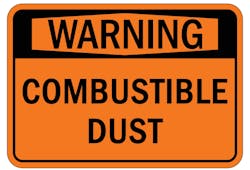Combustible Dust Safety: Expert Insights on NFPA 660 and Modern Protection Strategies
Key Highlights
NFPA 660 Consolidation: For the first time in over a century, all combustible dust standards have been unified into one comprehensive document, replacing multiple disparate standards with a single authoritative guide.
Four-Inch Rule Eliminated: The outdated "four-inch line rule" that exempted smaller diameter lines from isolation requirements has been abandoned, shifting responsibility to dust hazard analysis (DHA) for determining propagation risks.
No Grace Period for Compliance: Unlike previous standards, NFPA 660 provides no grace period between release and required DHA completion, meaning facilities must have assessments ready immediately when local authorities adopt the standard.
The combustible dust safety landscape has undergone a significant transformation. This evolution reflects an enhanced understanding of dust explosions through loss analysis of major industrial incidents, which has revealed critical gaps in fugitive dust control and explosion protection systems.
In a recent Chemical Processing roundtable discussion, industry experts gathered to discuss the evolving landscape.
Moderated by Jonathan McPherson, director of Advanced Manufacturing and Bulk Solids Technology Center at Kansas State University, the panel included Ashok Ghose Dastidar, vice president of dust flammability testing and consulting services for Fauske Associates; Jason Krbec, director of business development for CV Technology; and Andreas Brandl, chief technology officer for IEP Technologies.
All three companies were sponsors of this event.
Here were the major talking points:
What's Driving Recent Changes in Combustible Dust Standards?
The combustible dust safety landscape has undergone significant transformation in recent years, driven by several key factors. According to Krbec, one of the most significant developments is the consolidation effort that led to NFPA 660. "The long-term goal was really to consolidate all those standards into one big standard," Krbec explained. "That's what NFPA 660 agglomeration has become—that working document that all chapters work together."
This consolidation represents more than just organizational efficiency. As Dastidar noted, "This is actually the first time in over a century of publishing NFPA combustible dust standards that NFPA has finally created a one-volume tome that will help govern or provide guidance on combustible dust hazards." The move addresses usability concerns by providing guidance through "one voice" rather than multiple disparate documents.
Beyond organizational improvements, the industry has benefited from enhanced understanding of combustible dust phenomena through loss analysis. Dastidar highlighted the Chemical Safety Board's contributions: "By going through some of the bigger accidents in our country, we have come across several root causes. For example, like fugitive dust control and the fugitive dust problems that we have, the lack of explosion protection in a lot of the unit operations. Also in improved testing techniques."
Brandl emphasized the role of technological advancement: "Some of these changes also are stemming from the advancement in modeling and simulation techniques where you suddenly now can apply methods that were not so much available or widespread maybe 10 years ago." These modeling capabilities have enhanced product development and deepened understanding of combustion events.
The standards' living nature represents another advantage over static regulatory approaches. As Dastidar explained, "These documents are reviewed every three years and therefore modifications and updates are taking place. If this had been a government led documentation, it might've ended up as a static document that never gets updated."
How Have Line Isolation Requirements Changed?
The evolution of line isolation requirements represents one of the most significant shifts in combustible dust safety practices. The infamous "four-inch line rule" that once suggested lines under four inches in diameter didn't require isolation has been largely abandoned.
According to Dastidar, the original concept "was based on some work that was done in Europe by the Health and Safety Executive in the UK, and they showed that on pristine lines with nothing in there, if you had diameters less than four inches, the flame didn't propagate that far." However, real-world conditions proved this assumption inadequate.
"In a real-world environment where you have potentially salting in the line, some fuel already present four inches may not be specific enough or small enough to prevent mitigation," Dastidar continued. He noted that laboratory test apparatus much smaller than four inches can still propagate explosions, demonstrating the rule's limitations.
Brandl provided technical context for why line isolation matters: "It's important to distinguish or look at two effects. The first one is the pressure buildup in an adjacent vessel where you then potentially start the explosion at a pressure that's higher than what you expect. And then the second one is just the flame transfer and ignition."
The modern approach, as Krbec explained, shifts responsibility to the dust hazard analysis (DHA): "Your DHA is the document that should be determining whether you have propagation risks associated with a deflagration hazard in your vessel." This represents a fundamental change from prescriptive rules to performance-based assessment.
"It's probably the most overlooked thing I see in DHAs done is not a clear plan for whether or not an isolation point is needed or is required," Krbec noted, highlighting an implementation challenge in the transition to DHA-based determinations.
What Changes Have Occurred with Flameless Venting in NFPA 660?
Flameless venting requirements have seen relatively minor but important changes in NFPA 660. According to Brandl, the key consideration remains dual limitations: "We need to make sure that the pressure is reduced and doesn't exceed a certain pressure that is reported. But then on the other hand, we also need to make sure that there's sufficient heat capacity in the flame arrest available to quench that flame."
Volume limitations remain critical. "Flameless vents and flame arresters, they are tested and certified for certain volume and where the efficiency has been proven," Brandl explained. Exceeding tested volumes can compromise flame-arresting effectiveness. Additionally, using multiple vents can overwhelm individual flame arresters, with four generally considered a reasonable maximum number per vessel.
Krbec highlighted evolving certification standards as a more significant change than the NFPA requirements themselves: "The biggest change I've seen is some of the approval test standards that have been released in the last few years regarding flameless vent certifications and testing." FM Global's new approval standard addresses thermal loading and burning velocity concerns.
The dual nature of flameless vent protection creates complexity. "There's a pressure relief aspect to the flameless vent, but there's also the thermal loading that the mesh can actually absorb," Krbec explained. This thermal loading is affected by burning velocity and fuel concentration, creating dust concentration limits for flameless vents.
Misapplication remains a concern, particularly "on volumes that are very large or volumes that may have a really high suspended dust concentration, like on a dust collector when it pulses that may exceed the threshold of what the actual flameless vent can handle," according to Krbec.
Testing considerations have also evolved. Brandl noted that "ignition location... may affect how the flame arrest is thermally loaded," leading to changes ensuring worst-case scenario testing rather than less challenging conditions.
Dastidar pointed out that you really need to know your material. “Not only concentration and intensity, but what kind of combustion products could be developed. Especially if you're testing materials that could have halogen groups on the molecule or sulfur groups, you might be ejecting out fairly noxious gases like HCL or HF or hydrogen sulfite even. And therefore really, again through the DHA, decide whether your flameless vent is the most appropriate solution for protection of that particular enclosure.”
How Have Dust Hazard Assessments (DHAs) Changed?
The DHA process has remained largely stable through the transition to NFPA 660, with some notable additions. "I think the DHA process hasn't changed too much in 660," Krbec observed. "If you had done a DHA prior to that standard, your DHA is still going to hold up pretty well."
However, new requirements have been added. "There's been some additions though regarding some testing of combustible parameters, things like thermal instability," Krbec noted. These additions address previous gaps in material property assessment.
The isolation determination shift represents a significant change. "That isolation portion I mentioned earlier is a criterion. I think that it's a little bit more outlined, especially if you look at the agricultural chapter where determining isolation scenarios and propagation scenarios is now solely in the DHA scope," Krbec explained.
One critical change affects implementation timelines. According to Dastidar, "What a lot of people will realize when you're looking at 660 is that in the past 652 gave you a little bit of a grace period between when the standard was released and when your DHAs were supposed to be completed by. With 660, there is no grace period."
This represents a significant compliance consideration. "If you don't have one done now and your fire marshal your state or local fire code adopt 660, you really don't have that much runway to get that completed," Dastidar warned.
Brandl emphasized NFPA 660's role in raising DHA awareness: "What 660 does a good job in is making the industry aware that this is a key document when you start to look at your process and that your hazards, the DHA, really is your key document to keep your process safe."
Who Is Authority Having Jurisdiction (AHJs) and How Do You Work with Them?
Understanding and working with Authority Having Jurisdiction represents one of the most complex aspects of combustible dust compliance. As Brandl explained, "There's so many options. So AHJ really could be some local authorities like fire marshal, state officials or very often it's insurance providers that take the role of the AHJ, whoever really can approve such a document and solutions."
The multiplicity of AHJs creates complexity. Krbec noted, "You can have more than one AHJ. You can have a lot of different AHJs in some cases, and they can come in different shapes and sizes." Insurance carriers have become increasingly involved, "more and more involved in projects... they've kind of involved themselves more as in an AHJ role than maybe even in the past."
A significant challenge involves AHJ expertise levels. "We still have a little bit of a gap and a challenge with certain AHJs not fully understanding the hazards around combustible dust," Krbec observed. "Not every fire marshal is an expert in combustible dust. Their expertise is fire, and in most cases they're worried about sprinkler codes and means of egress and firewall ratings."
This knowledge gap requires industry adaptation. "Sometimes you're even educating the AHJ if you go to them with a plan of attack to handle your combustible dust hazards," Krbec noted.
Dastidar highlighted the consensus requirement challenge: "All of them have to be satisfied. So it's sort of like a unanimous vote from all your AHJs is important for you to then proceed onward." This becomes particularly complex when dealing with performance-based approaches versus prescriptive requirements.
The performance-based challenge is significant. "With the performance-based approach, your AHJ may not necessarily be skilled enough or informed enough to actually discern whether that type of approach is appropriate or not," Dastidar explained. Fire marshals have indicated they would struggle to evaluate performance-based designs because "they just wouldn't understand."
The recommended approach involves early engagement: "You need to get your AHJ, enumerate them at the very beginning and get them on board as you go through the process of developing a combustible dust program at your facility."
How Should Effective Vent Areas Be Tested for Different Dust Types?
The relationship between dust characteristics and effective vent area requirements represents a critical safety consideration. An audience question addressed how effective vent areas should be tested with different dust types, including fine dust, coarse dust, metal dust and smelting dust.
Brandl emphasized the fundamental approach: "Typically the way you characterize your dust is dust testing and you get some of the key values, KST values, P max values that you need for your testing, and really based on the vent area that's required for a given enclosure really depends on these characteristics."
Different dust types create distinct challenges. Krbec explained, "Those different types of dust really impact the flame arresting material and especially metal dust, specifically some of those coarse dust, the melting types of dusts, they affect the mesh efficiency by really blocking it and clogging it."
Metal dusts present particular concerns: "Metal dust, you're really worried about the burning temperature of the metal and what's that doing to your flame-arresting material? Is it melting it so you're not getting the pressure relief you need, or is it just overwhelming it and you're not getting the thermal absorption you need out of the flame?"
The reality of dust behavior in process equipment affects testing relevance. "In a given enclosure, if it's going to become turbulent, it might actually be the finer fraction of that distribution that actually participates in the explosion," Dastidar noted. This means sampling location matters significantly.
"When you're looking at these things for effective vent area, don't necessarily sample from the cone section of your cyclone or your baghouse or dust collector, maybe look at what's going to be stuck to the walls or what's stuck to the actual filter media," Dastidar recommended.
What Options Exist for Managing Explosion Vent Hazard Zones?
Managing explosion vent discharge hazards represents a common industrial challenge, particularly when vent discharge areas contain equipment or present personnel exposure risks. The panel addressed various mitigation strategies for these situations.
Dastidar emphasized the extent of hazard zones: "People forget that the fireball from an explosion relief vent can travel dozens of yards away from the actual source. So when you look at a hazard zone, you don't really expect it to be that large, but it can be that large."
Deflection represents one solution approach. "You can deflect the flame upwards or ducted away," Dastidar noted. However, the primary consideration remains personnel safety: "Are people going to be impacted? And then if this is impinging on equipment, could it compromise equipment?"
Brandl suggested case-by-case evaluation: "It depends on what the equipment is. If it's a solid concrete silo, it may not be detrimental compared to other equipment." However, he emphasized ensuring proper venting fundamentals, particularly avoiding indoor standard explosion venting.
Krbec outlined multiple technical alternatives: "There's ways to deflect the flame ball out of the vent area. We talked about flameless venting. That's always an option you could look at doing here, although it will change your affected vent area a little bit on the vessel."
"Chemical suppression is another option you can look at," Krbec noted, though this changes the protection approach entirely.
Performance-based design offers additional flexibility. Krbec explained that flame balls are "a very short impulse... it comes out and it goes very far, but it's a short-duration flame exposure." This characteristic enables performance-based evaluation of flame ball impact on nearby structures.
Modeling capabilities support these evaluations. "There's a number of consultants that can do that type of modeling. There are software packages out there, FLACS that has some combustible dust modeling availability," Krbec noted, though he recommended engaging qualified consultants for proper implementation.
About the Author
Traci Purdum
Editor-in-Chief
Traci Purdum, an award-winning business journalist with extensive experience covering manufacturing and management issues, is a graduate of the Kent State University School of Journalism and Mass Communication, Kent, Ohio, and an alumnus of the Wharton Seminar for Business Journalists, Wharton School of Business, University of Pennsylvania, Philadelphia.


